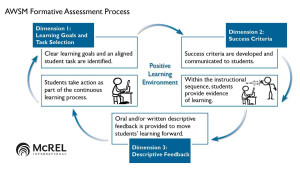How does student work inform instruction? I read Katrina Schwartz’s MindShift blog post, “How Looking at Student Work Keeps Teachers and Kids on Track,” and immediately found connections to McREL’s Institute of Education Sciences (IES) study of a formative assessment model for middle school math, now completing its third year. Not only does Ms. Schwartz highlight the use of student work as a method for improving student learning and teacher practice—a cornerstone of our study—but she also relates this to mathematics.
For the IES study, McREL’s math and assessment specialists developed a program that provides teachers with authentic samples of student math work and an interactive, hands-on experience to increase their use of high-quality formative assessment practices. The program, called AWSM (shorthand for Learning to Use Formative Assessment with the Assessment Work Sample Method), has a goal of increasing middle school students’ math achievement.
AWSM differs from other formative assessment professional development in that it:
- focuses specifically on middle school mathematics,
- features supportive peer review of colleagues’ assessment practices,
- centers on the use of student work samples,
- is job-embedded, and
- fosters teacher collaboration.
Teacher data from our pilot tests are quite promising, and many of the points that Ms. Schwartz identified in her blog post were evident in our study. For example, Ms. Schwartz noted that often students don’t have a “clear sense of what a great project would look like.” AWSM is designed to help teachers articulate a clear learning goal, select or develop a mathematically rich aligned task, and communicate the criteria for successful task completion to students. With clear success criteria in place, students can track their own progress, provide descriptive feedback to peers, and make adjustments in their own learning.
Interestingly, resisting the pressure to grade every assignment is a challenge for teachers in the AWSM program. AWSM promotes using descriptive feedback, rather than grades, when students are learning a new concept or skill, and, for some teachers, this conflicts with current practice and beliefs. When students receive a letter grade or number score on an assignment, they tend to pay little attention to the descriptive feedback offered by teachers, often missing important recommendations that could help them improve their work. Ms. Schwartz notes that looking at student work can bring the focus back to the learning goals, and this is echoed in our work with AWSM.
Using high-quality formative assessment practices requires many teachers to make significant shifts in their practice, as illustrated by these teacher comments gathered at the end of the pilot test:
“I used to think formative assessment was about the teacher knowing where students are in the learning process. Now I know that formative assessment must include students so that they understand how to improve their own learning.”
“I used to think I had to grade everything. Now I know I can provide descriptive feedback and allow students to take action.”
“It’s the dimensions of clear learning goals and success criteria that have most impacted my instruction. I think I was always clear about what was being learned, but I needed to be more explicit about sharing this information with my students.”
The AWSM team is disseminating study findings at conferences across the U.S. in 2014 and 2015. If you’d like more information about the program, please feel free to contact me directly at kdempsey@mcrel.org.



As a middle school math teacher, I am always trying to find the best way to provide feedback to my students. However, I find it difficult to go through each of their assignments to check for understand and problem-solve where their errors may be in understanding the skill. I look forward to reading more about the AWSM Formative Assessment Process to see if it would fit in my classroom and building.
Thanks for your comment. Participants in the AWSM program also indicated that they struggled with time constraints. However, with clear goals and success criteria, students were better equipped to identify their own errors and help peers recognize missteps as well. Although this doesn’t replace the important feedback provided by the teacher, it does help students make learning adjustments and build a sense of self-efficacy for learning mathematics. Of course, all of these strategies are only effective if the classroom culture is a safe place for making mistakes and learning from them.
I homeschool children who can’t get into the education system, for various reasons, in France. These children often feel broken by the system because many of them have special needs that aren’t addressed, or have not been addressed properly. I have essentialy eliminated grades due to the fact that these children “freeze” when we put a grade to their work. I have ben the one to evaluate their work, however, I think it is a good idea that the srudent participate in the evaluation process. Can you give me more information on this process and how to work it individually to allow the child to feel their accomplishments and eventually come to a satisfactory means of “grading”?